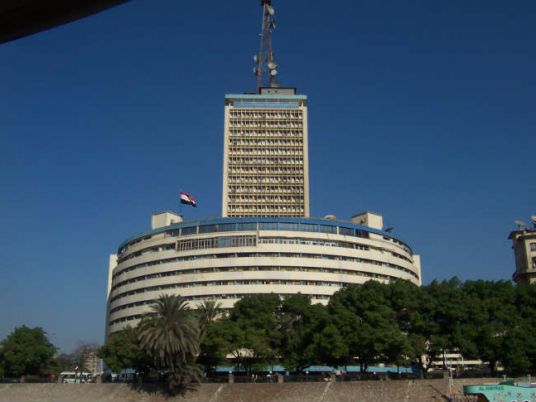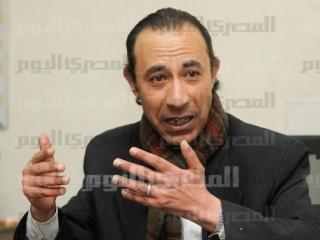For decades, getting into the Maspero building on the Nile Corniche has been a practically impossible task. The state TV building, established in 1960 and named after French Egyptologist Gaston Maspero, has a tedious line of security checkpoints and labyrinthine gates.
This inaccessibility may change soon, but it will have nothing to do with the cumbersome state institution itself, which has remained closely guarded by the Egyptian military since 28 January despite numerous protests calling for the purging of state media.
Instead, people will get to witness a symbolic version of Maspero just kilometers south of the actual building, where a group of artists have set up an exhibition in small alley in Old Cairo, known as Darb 1718, that investigates the relationship between state propaganda and architecture.
At the entrance to the “Maspero” exhibition, audience members are greeted by a blue stencil of the Maspero building’s architecture, which highlights its convoluted doorways and corridors. The piece, entitled “Blueprint,” is the latest work of Egyptian graphic artist Adham Bakry.
Invited to reflect on the state media apparatus by first-time curator and Al-Masry Al-Youm reporter Ali Abdel Mohsen, Bakry adopted a purely architectural approach, and after long research, came across a blueprint of the building at Cairo University.
“Everybody thinks that the building is circular and people don’t know about the side entrance to Maspero,” Bakry tells Al-Masry Al-Youm on the exhibit’s opening night. “They should, though, because for the revolution to be completed, Egyptians should take over the building symbolically. And there’s no better chance than with this exhibit, as audience members can contemplate the stencil and even photograph it, taking the design home with them.”
The political view of Maspero as a tool for state propaganda has motivated the artists to populate the “Maspero” exhibit, yet has prevented them from addressing state TV from a cultural perspective.
In Nermine al-Ansari’s “Radiation and Radio,” the artist, known for her work on cityscapes, also explores the role of the media apparatus by imagining its architectural design, albeit in a fashion very different from Bakry's. In a wall-sized painting, Ansari morphs the Maspero building into a “weapon of mass destruction,” replete with abstract human figures suspended in the air, failing to escape its radiation.
“I see the effect of Egyptian state TV on people as very similar to that of radioactive materials and weapons of mass destruction,” she says.
Although the analogy of a state using TV to control its citizens is fairly straightforward, the concept is difficult to display in art. Taking on such a literation translation in a painting of this size – unlike her previous small-scale drawings – required greater detail in order to hold the attentions of viewers and engage them visually with the work.
Hany Rashid has approached the exhibition's theme quite differently through “Hekayat Maspero” (Stories from Maspero). The work offers excellent insights into the internal politics of state TV, as well as the social and cultural lives of its large staff.
Last May, the 36-year-old artist began publishing, on a Facebook page bearing the same title, textual reflections on everyday happenings within the building, where he worked as a sound engineer for 16 years. Attached to each story is a photograph or administrative document that Rashid has collected over the years and painted about.
With a dark sarcastic tone, Rashid presents Maspero as a microcosm of Egypt, reflecting on the government bureaucracy, common cultural values and socioeconomic conditions of the Egyptian middle class, all while acknowledging his own role in the system.
In one story, Rashid recounts how former president of the Shura Council, Safwat al-Sherif, then still the minister of information, took former President Hosni Mubarak on tour to see the new state TV production studios, only to have him watch programs from the old studio on a monitor. Other stories recall his encounters with co-workers, TV stars, a prospective loved one and even his artistic mentor, visual artist Mohamed Abla, in 1994.
“Hekayat Maspero” is nicely fleshed out. Printouts of the stories are hung along a wall, surrounded by Rashid’s signature monochromatic drawings and three-dimensional painted assemblages of TV personnel. Animated in style, like many of his pop-art works, the characters are grouped to reflect the power relations between the employees and their superiors, as well as amongst themselves.
“I’m using text for the first time, yet I see the image as integral to the stories I’m writing,” Rashid says. “Text is one of many facets to my ongoing project, which includes documentary photographs I took with actresses, documents, and invoices from my collection as well as my father’s, who works at Maspero.”
The exhibit is crammed in an attic-style presentation, with a display table at its center. Inside its glass vitrines lie a selection of photographs of Rashid as a child accompanying sound crews to shootings, as well as pictures Rashid took with Egyptian celebrities on various program sets. But most intriguing are the internal documents and listings of TV programs like “Allam al-Behar” (Underwater World) and “Allam al-Haywan” (Animal World), two documentary programs which people followed closely on weekends back in the 1980s and 90s, when satellite TV was still a privilege.
Focusing more on TV programming is Ibrahim Saad’s multi-channel video work “Ikhtarna Lak” (Our Selection). The title of the piece is a spin on the 90s Wednesday night variety show. Working with two actors, Saad recreates a caricaturist version of many sports, music and variety shows that aired on state TV, dubbing the TV channel on his five screens as “Isfaf TV” (Mediocre TV). Trying to be critical of the content in a humorous way, the videos create a stir, yet end up presenting a simplistic look at cultural production popular at the time.
Perhaps a stronger work on the hypnotizing effect of state TV programming is Amanda Kerdahi’s and Obada’s “Remember to Feed the Fish,” which is presented on the top floor of Darb 1718. The artists recreate a living room set-up with one sofa facing TV test bars, which are illustrated by a colorful striped piece of cloth illuminated from behind. Featuring a small tank that a dead fish floats in, the exhibit reminds audience members of the draining experience of watching state TV for long hours in the dark confines of one’s living room.
Next to this exhibit, Ahmed Sabry re-displays his “Al-Brince TV” painting series. A commentary on the use of television as a tool to control the masses, Sabry compares TV programmers to artists in medieval Europe, who worked on spreading the ideology of the church. The analogy is interesting, yet most of the small paintings, showing advertising and music video clips, reference private satellite TV programming, rather than Maspero productions. Still, beginning in the new century, state TV under former Minister of Information Anas al-Fiqqi adopted an approach very similar to private satellite programming, giving the work relevance.
Refreshing as it is to witness how artists working through different media have responded to state TV, most artists seemed trapped in presenting Maspero as a political symbol of the former regime, probably because most problems of state media persist today.
State television's experimentation in music, film and set design in the 90s, for instance, are ignored at the exhibition. Creative productions during that period surpassed the adaptations of Western cultural production that was common in the 80s, yet gradually died out in the new millennium. Whether this was due to limited support structures, an inability to keep up with private channels, or even a disinterest on the part of the state, unfortunately, they emains unexplored, confined to the minds of members of the 90s generation. It's a shame, then, that almost none of the "Maspero" artists tap into the cultural role of Maspero.
“Maspero” is being shown at Darb 1718 until 30 August
Location: Qasr al-Shamei Street, Al-Fakhareen, Old Cairo
The gallery is open Saturdays through Wednesdays from 10:00 to 14:00 and
16:00 to 21:00; and from 16:00 to 21:00 on Fridays
The participating artists are: Engy Aly, Ali Abdel Mohsen, Nermine al-Ansari, May al-Hossamy, Adham Bakry, Khaled Hafez, Amanda Kerdahi, Moataz Nasreldin, Obada, Hany Rashed, Ibrahim Saad and Ahmed Sabry
The exhibition is curated by Al-Masry Al-Youm reporter Ali Abdel Mohsen



